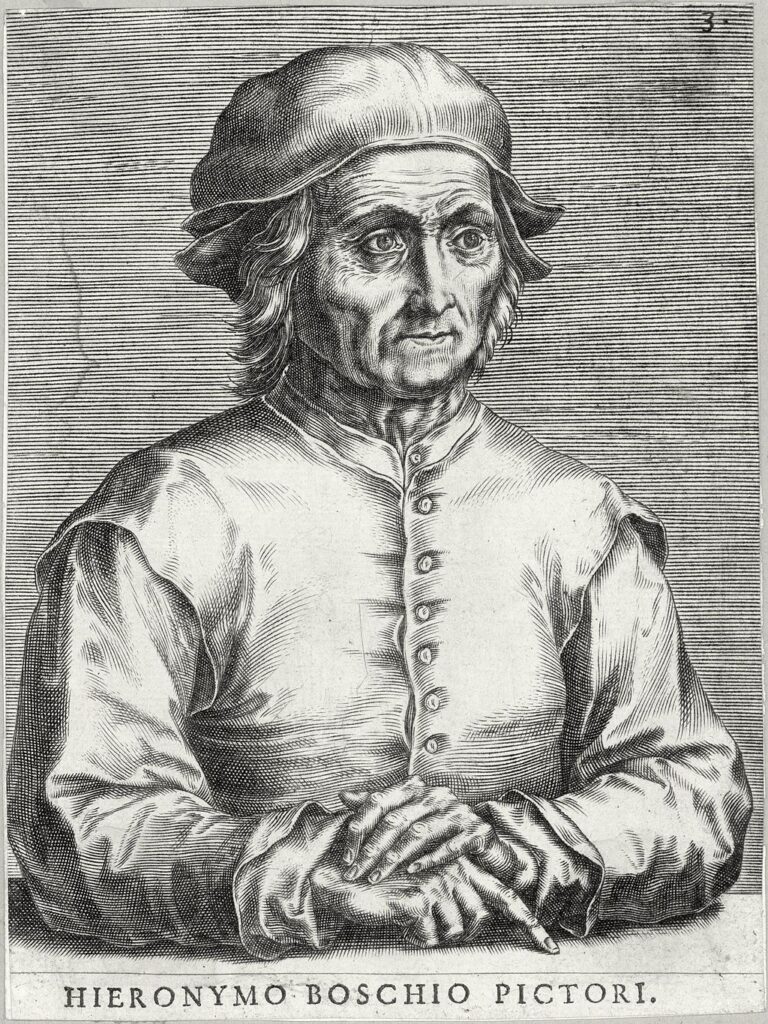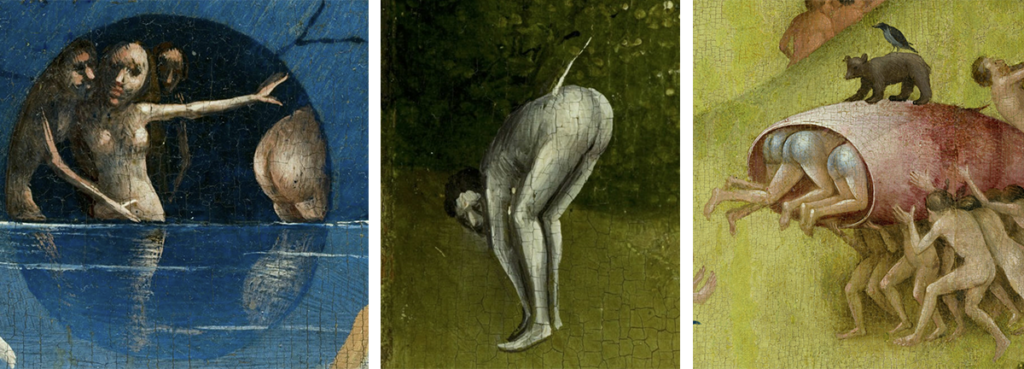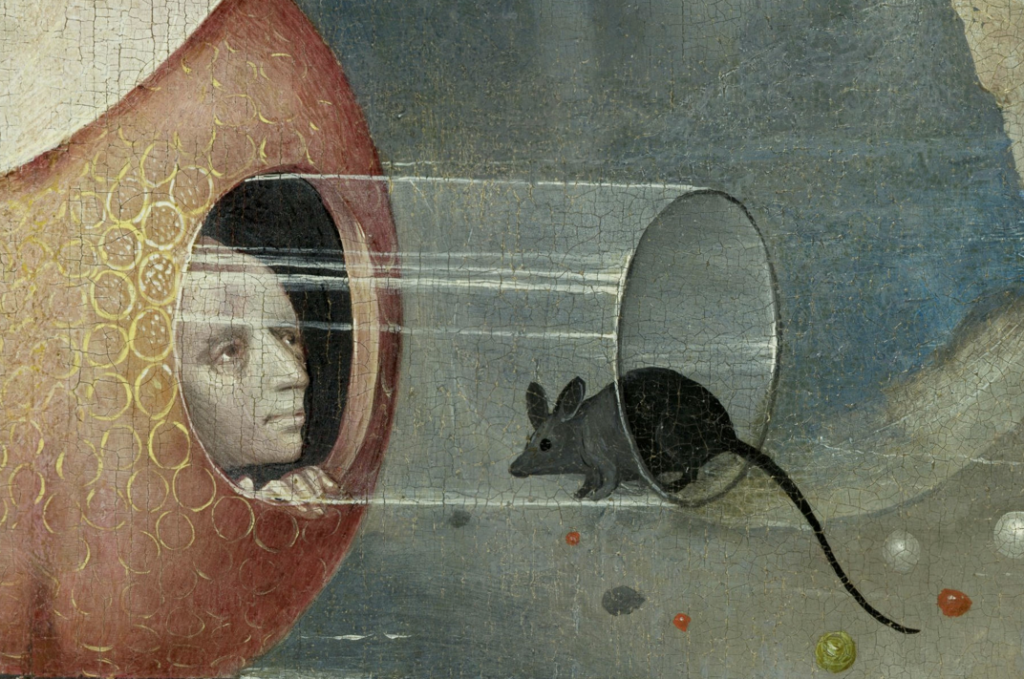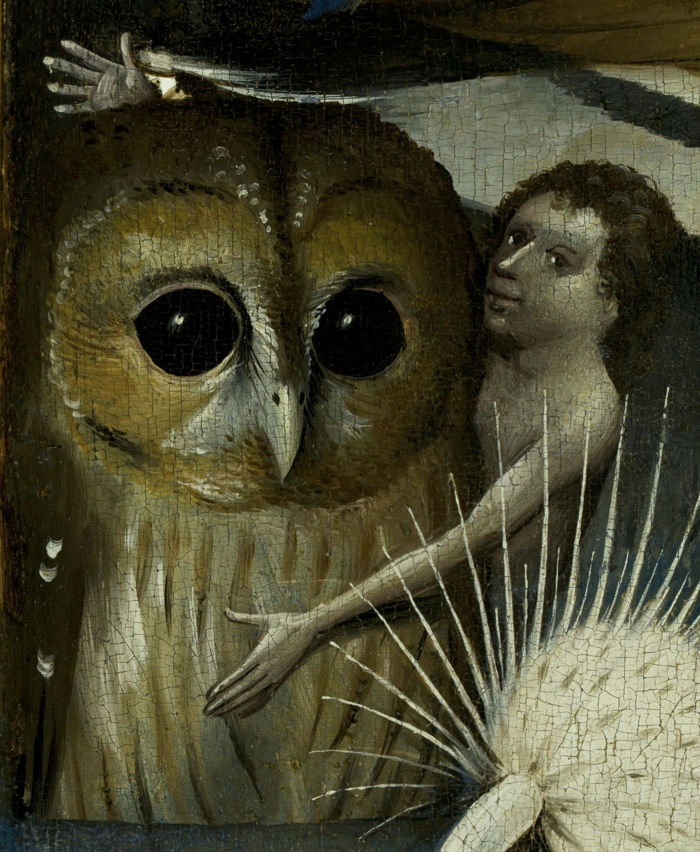Sex and Frenzy in the Central Panel of Bosch’s ‘The Garden of Earthly Delights’

I spy with my little eye: two people copulating inside an oyster, a frog with no arms (or a fish with legs?), a mob of people climbing eagerly into a broken egg, and a boar with blueberries for tentacles.
Behold – The Garden of Earthly Delights.
To clear a few things up about this incredibly bizarre piece of art: yes, it was created over 500 years ago and yes, this is a religious painting. Despite looking like a surrealist nightmare, The Garden of Earthly Delights is actually quite old, and at first glance does not look like the type of artwork you might imagine coming from this time period.
It’s also the type of painting that, the longer you look at it, the weirder it gets. Wikipedia offers an incredibly high resolution version of The Garden of Earthly Delights allowing you to zoom right in on the tiny bizarre details. It’s these tiny details, sometimes vulgar, sometimes funny, and sometimes too strange to comprehend, that I want to share because it’s my mission in life to show people that art history is actually an incredibly fun topic to learn about.
A Quick Breakdown – What Exactly am I seeing?

The Garden of Earthly Delights is a triptych (artwork divided into three pieces) painted with oil on oak panel. It was painted sometime between 1490 and 1500 by Hieronymus Bosch, a Netherlandish artist who specialised in fantastic depictions of religious scenes. The Garden of Earthly Delights is actually one of three large triptychs painted by Bosch (the others being The Last Judgement c.1482 and The Haywain Triptych c. 1516) though this one is definitely the most detailed and most bizarre.
The Garden of Earthly Delights is split into three scenes, one on each panel. The left panel shows the Garden of Eden, complete with Jesus, Adam, and Eve featured on the green hills on the lower half of the scene. The right panel shows Hell, depicting the damned in various creative ways. In the centre we have The Garden of Earthly Delights itself, in all it’s bizarre and questionable glory. There are a lot of conflicting interpretations of the triptych as a whole, especially since little is known about Bosch himself and what his intentions were with this piece. And though we don’t know who exactly commissioned The Garden of Earthly Delights, it’s very unlikely that it was intended to be displayed in a church or monastery due to the intensity of the subject matter. Possible patrons include King Philip II of Spain, his nephew Englebert II, or an unknown individual of high economic status.
But just because the painting is religious in nature doesn’t mean we can’t think it’s weird — because it is weird and art exists to be reacted to. So if we think it’s strange and it makes us laugh or feel uncomfortable, that’s okay! It’s all part of the enjoyment of looking at artwork. And in fact Charles de Mooji, director of the Noordbrabants Museum in Den Bosch told the BBC that he believes Bosch “must have been a man of humour. Look how he enjoyed painting the strangeness of life.” Unsurprisingly, some surrealists artists, active 400 years after Bosch, consider him to be a forerunner of their art movement. Salvador Dali himself studied Bosch’s work, and we are all too familiar with the strangeness of Dali’s dream worlds.
The Central Panel in All Its Insane Glory
The main theme of the central panel of The Garden of Earthly Delights, if you couldn’t tell, is sex, lust, passion, and ecstasy. It’s basically a really big, strange orgy. At the time, the popular thirteenth-century French poem Le Roman de la Rose (Romance of the Rose) had been translated into Dutch and might have served as some inspiration for Bosch’s Garden of Earthly Delights. Some interpretations think that the central panel depicts humanity being driven to insanity by indulging in sin.
Since it’s very easy to get overwhelmed with the sheer amount of insanity going on in this panel, I’ve pulled out a few of my favourite scenes for us to scratch our heads at.
Humans Exposing Themselves in Strange Ways
Let’s jump right into it — there’s a lot of butt stuff going on here, to put it bluntly. Once you notice it you can’t help but see it everywhere. Sometimes it’s just people bending over, sometimes it’s people getting things uh.. inserted in them, and sometimes the things being inserted are bird beaks. Don’t worry, the birds seem to be initiating it themselves, if that makes it any less weird (it doesn’t). There’s also a number of men doing a spread-eagled headstand, with all their bits and bobs exposed.


And I can’t tell if this person is inserting flowers into the other person’s butt, or if he is picking flowers out of it. Is this some sort of ‘my farts smell like roses’ joke? I wouldn’t be surprised because that specific form of humour has been around for a long, long time.

Then there are just plain ol’exposed bums. And there’s quite a few of them, but I’ve included a few notable examples below. My favourite is the guy in the middle scene below — while all the other figures are engaged with each other or with the animals, this guy is bending over, completely alone, along the left side of the central panel. What’s his story? Is he okay? Also the blue butts on the right… I have so many questions, but I’m not sure I want answers.

While the central panel is rife with homosexual undertones, this wasn’t intended to promote early acceptance of the LGBTQ+ community. During the Middle Ages, acts of homosexuality were referred to as sodomy. Sodomy also referred to any sexual acts that were not done for the purpose of reproduction (for example, sex with animals), which made sodomy a sin. In The Garden of Earthly Delights, the implication of acts of ‘sodomy’ were not meant to be received positively, but as a form of warning against the dangers of falling for sinful temptations.
Humans Being Weird with Animals
This doesn’t include the weird bird beak/butt situation above… that really needed it’s own category.
To begin, we have a man encountering a rat or mouse in a short translucent tube that sticks out from the side of a large egg. It’s uncertain if the man is welcoming the rat into his egg, or if there is some animosity towards the critter. It doesn’t help that everyone’s facial expression in this panel is so neutral. It’s almost as if their desire and lust is consuming to the point that they’re acting on auto-pilot.

There’s a repeated motif amongst the central panel of birds feeding fruit to humans as if they were their own hungry babies. And the humans are more than eager to retrieve the delicious fruit from their feathery mothers.

This guy just wants to show you his new owl best friend. I’m not sure if I find it wholesome or unsettling.

Bosch often included owls in his paintings, and the central panel of The Garden of Earthly Delights is no exception. While the gentleman above looks pretty pleased with his close proximity to an oversized owl, the symbolism of the creature is much more sinister. According to the Museum del Prado (where the triptych is currently on display), “Bosch particularly emphasizes two different types of owl that evoke evil” within the central panel and that both owls stare directly at the viewer with a strong unwavering gaze. In Leviticus 11:13-18, it is written that owls are “birds you are to detest and not eat.” And Pliny the Elder, in the 1st century CE, wrote that owls are “thought to be a very bad omen, being as it is a funeral bird” and Isidore of Seville during the 7th century CE said “it is a deadly bird, burdened with feathers and with a heavy laziness.” And around the 1500s when this painted was created, owls were associated with menace and death and had “moralistic significance.”
The situation in the sky isn’t any less strange. Here we have a man riding a griffin with a bear clutched in its taloned grip. Above the man, a bird has been given the gift of flight without having to actually flap his own wings, since the man holds a tree in the air to act as the bird’s sky-bound perch. The chain of command here is interesting, it seems as though the bird is possibly the one steering the sentient airship.


In terms of symbolism, the griffon to the medieval mind was seen as having dominion over both the land and the sky since the creature was a combination of a lion and an eagle. Which is all fine and well, but where are our friends flying off to? The way the man holds the tree almost implies its use as a weapon, perhaps a lance used in medieval jousts. And on the opposite side of the panel we see a hybrid of a knight and a sea creature riding a flying fish and holding its own weapon of a spear with an apple dangling from the end. Are these two scenes meant to go together? Are they fighting for honour, or is their bizarre sparring match an act of entertainment for the onlookers below? Either way, no one seems to notice anything odd happening in the sky, they’re too preoccupied with their own temptations.
Humans Making Creepy Eye Contact with the Viewer
I’m specifically talking about these two:

Amongst all this chaos, at the bottom of the panel are two men looking directly at the viewer in a ‘don’t you wish you were here with us too?’ kind of way. The answer is definitely no, I think I’ll pass, thanks. But their presence is incredibly jarring when you casually zoom in around all the strange happenings. Everyone seems to be in their own world, but for some reason these two weirdos want you (yes, you!) to know that they know you are also tempted by such earthly pleasures, one way or another.
Strawberries are featured so heavily in the central panel that the painting used to be referred to as ‘the strawberry painting’. The delicious red fruit has a history conflicting of symbolism. During the Middle Ages, strawberries were often used in paintings of the Virgin Mary as well as scenes of the Resurrection. Alternatively, strawberries were also seen as erotic. The Garden of Earthly Delights is overflowing with strawberries, and I don’t think they’re being used in this particular instance to represent the Virgin Mary. Even today, the strawberry continues to be a symbol of lust and romance. Chocolate covered strawberries, anyone?
The humans feasting and copulating on or around fruit in the painting could also be seen as the continuation of the cycle of sin committed by Adam and Eve, who are featured on the left panel. In the book of Genesis, God allows Adam and Eve to eat any of the fruit in the Garden of Eden except fruit growing on the Tree of Knowledge of Good and Evil. A talking serpent encourages Eve to pluck and eat forbidden fruit from the tree, which she then passes onto Adam. God banishes Eve and Adam (as well as the serpent) from the Garden of Eden for fear that they be tempted again to eat fruit from the tree of life which would allow humans to live forever. Some food for thought when considering the vast amount of erotic and sinful pleasure everyone seems to be getting from eating all those delicious looking berries (pun intended).
This barely scratches the surface of the insanity found in this magnificent painting. For a wonderful interactive look at the three panels of The Garden of Earthly Delights, I highly suggest visiting the interactive documentary Hieronymus Bosch, The Garden of Delights. It includes an audio commentary and virtual tour of some highlights of the triptych, as well as information on the two exterior panels.
Sources and Additional Reading
Artsy – Decoding Bosch’s Wild, Whimsical “Garden of Earthly Delights”
British Library – Roman de la Rose
BBC Culture – Hidden meanings in The Garden of Earthly Delights
BBC Culture – The ultimate vision of hell
The Medieval Bestiary – Owl
Bible Gateway – Genesis 3 (King James Version)
Daily Art Magazine – Hieronymus Bosch’s Creepy Owls
Mental Floss – 15 Things You Should Know About Bosch’s The Garden of Earthly Delights
Museo del Prado -The Garden of Earthly Delights
The Gardens Trust Blog – Saints, Sinners, Sex and Strawberries…
The Great Courses Daily – The Garden of Earthly Delights
University of Notre Dame, Medieval Studies Research Blog – Owls: Always a Hoot?
Wikipedia – Adam and Eve
